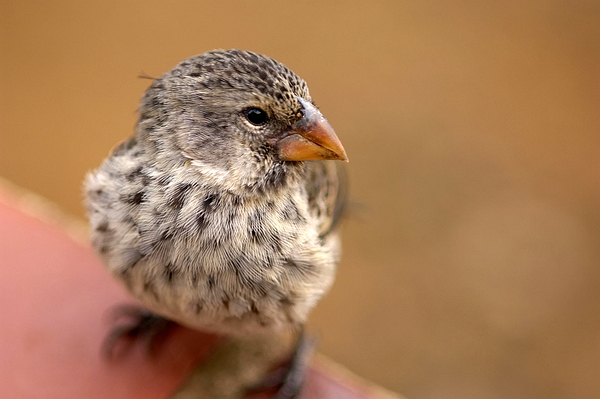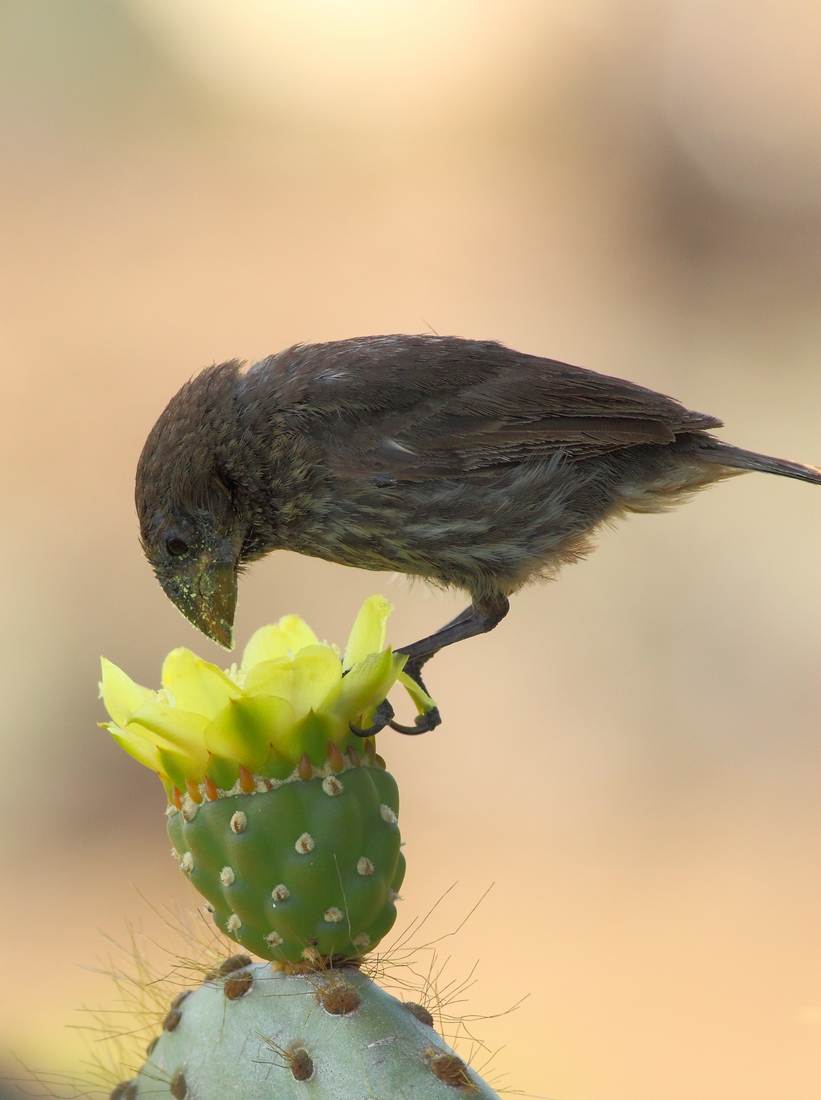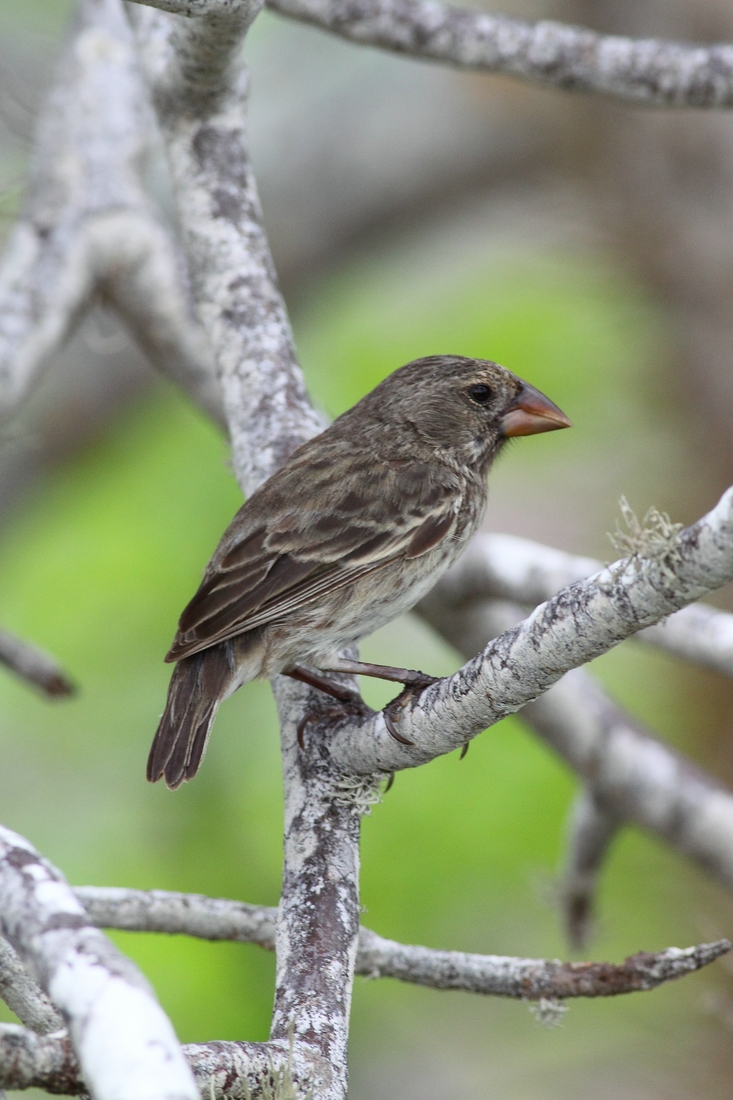Galapagos Species Database
The Galapagos Species Database shares the information about the species from our Natural History Collections.
Geospiza fortis
Pinzón Terrestre Mediano, Pinzón mediano de tierra, Medium Ground Finch







In Santa Cruz, there are small beaked and large beaked birds; the latter can be confused with large ground finches, but beak depth is less and overall impression is smaller than large ground finch.
Threats Main threats are probably rats and disease. It is known to be affected by the parasitic fly Philornis downsi that causes heavy chick mortality.
Domain
Eukaryota
Kingdom
Animalia
Phylum
Chordata
Class
Aves
Order
Passeriformes
Family
Thraupidae
Genus
Geospiza
Species
fortis
Taxon category: Accepted
Syn: Geospiza dubia (Gould, 1837); Geospiza dentirostris (Gould, 1837).
Taxon origin: Endemic
Feeding preferences: Mainly seed eater but visits also flowers and may be an important pollen vector.
Trophic role: Herbivorous
Reproduction mode: Exclusively sexual
Reproductive biology: Male displays in front of a dome shape nest, often built in Opuntia cacti. Only females are incubating (three to five eggs), both feed the chicks.
Map of specimen collection localities or observation records for this species in our collections database.
Distribution: Widespread on all main islands except Darwin, Genovesa, and Wolf (where one was collected in 1906). In 1905-1906 fifteen non-breeding birds were collected on Española, but they may be stragglers or part of a now-extinct population.
- Wiedenfeld, D.A. (2006) Aves, the Galapagos Islands, Ecuador. Check List 2006 2(2): 1-27.
- Jiménez-Uzcátegui, G. Milstead, B., Márquez, C., Zabala, J., Buitrón, P., Llerena, A., et al. (2007) Galapagos vertebrates: endangered status and conservation actions. Galapagos Report 2006–2007. Charles Darwin Foundation, Puerto Ayora, p. 104–110.
- Harris, M.P. (1973) The Galápagos avifauna. Condor 75(3): 265-278.
- Salvin, O. (1876) On the avifauna of the Galápagos Archipelago. Transactions of the Zoological Society of London 9: 447-510.
- Sundevall, C.J. (1871) On birds from the Galápagos Islands. Proceedings of the Zoological Society of London 1871: 124-129.
- Fessl, B. Tebbich, S. (2002) Philornis downsi - a recently discovered parasite on the Galápagos archipelago - a threat to Darwin's finches? Ibis 144: 445-451.
- McQuistion, T.E. Wilson, M. (1989) Isospora geospizae, a new coccidian parasite (Apicomplexa: Eimeriidae) from the small ground finch (Geospiza fuliginosa) and the medium ground finch (Geospiza fortis) from the Galapagos Islands. Systematic Parasitology 14(2): 141-144.
- Thiel, T. Whiteman, N.K., Tirapé, A., Baquero, M. I., Cedeño, V., Walsh, T., Jiménez-Uzcátegui, G. & Parker, P.G. (2005) Characterization of canary pox-like viruses infecting endemic birds in the Galapagos Islands. Journal of Wildlife Diseases 41(2): 342-353.
- Swarth, H.S. (1931) The Avifauna of the Galapagos Islands. Occ. Pap. Calif. Acad. Sci. 18: 1-299.
- Huber, S.K. (2008) Effects of the introduced parasite Philornis downsi on nestling growth and mortality in the medium ground finch (Geospiza fortis). Biological Conservation 141: 601-609.
- Fessl, B. Kleindorfer, S. & Tebbich, S. (2006) An experimental study on the effects of an introduced parasite in Darwin’s finches. Biological Conservation 127(1): 55-61.
- Fessl, B. Couri, M.S. & Tebbich, S. (2001) Philornis downsi Dodge & Aitken, new to the Galapagos Islands (Diptera, Muscidae). Studia Dipterologic 8: 317-322.
- Kleindorfer, S. Dudaniec, R.Y. (2006) Increasing prevalence of avian poxvirus in Darwin’s finches and its effect on male pairing success. Journal of Avian Biology 37: 69-76.
- Jiménez-Uzcátegui, G. Betancourt, F. (2008) Avifauna vs automotores. Informe Galápagos 2007-2008. FCD, PNG & INGALA. Puerto Ayora, Ecuador. p. 111–114.
- Bisconti, M. Landini, W., Bianucci, G., Cantalamessa, G., Carnevale, G. Ragaini, L. & Valleri, G. (2001) Biogeographic relationships of the Galapagos terrestrial biota: parsimony analyses of endemicity based on reptiles, land birds and Scalesia land plants. J. Biogeogr. 28: 495-510.
- Donohue, K. (2011) Darwin's Finches: Readings in the Evolution of a Scientific Paradigm University of Chicago Press, Chicago, 492 pp.
- Alatalo, R. V. (1982) Bird Species Distributions in the Galapagos, Ecuador, and Other Archipelagoes: Competition Or Chance?. Ecology 63 (4): 881-887
- Grant, P.R. Grant, B.R. (1987) Interacciones entre plantas y animales: consumo de semillas por los Pinzones de Darwin. Memorias. Investigación Botánica y Manejo en Galápagos. Pg.199-209
- Koop, J. A. H. Huber, S. K., Laverty, S. M. & Clayton, D. H. (2011) Experimental demonstration of the fitness consequences of an introduced parasite of Darwin’s finches. PLoS ONE, 6(5):e19706, doi: 10.1371/journal.pone.0019706.
- Koop, J. A. H. Owen, J., Knutie, S., Aguilar, M. & Clayton, D. (2013) Experimental demonstration of a parasite-induced immune response in wild birds: Darwin’s finches and introduced nest flies. Ecology and Evolution 3:2514-2523.
- Boag, P.T. (1984) Growth and allometry of external morphology in Darwin's finches (Geospiza) on Isla Daphne Major, Galápagos. Journal of Zoology 204:413-441.
- Gibbs, H. Grant, P. (1987) Adult survivorship in Darwin's Ground Finch (Geospiza) populations in a variable environment. Journal of Animal Ecology 56:797-814.
- Grant, B.R. (1996) Pollen digestion by Darwin's finches and its importance for early breeding. Ecology 77:489-499.
- Grant, B.R. Grant, P.R. (1996) High survival of Darwin's finch hybrids: effects of beak morphology and diets. Ecology 77:500-509.
- Grant, B.R. Grant, P.R. (2010) Songs of Darwin’s finches diverge when a new species enters the community. Proceedings of the National Academy of Sciences 107:20156–20163.
- Levin, I.I. Zwiers, P., Deem, S., Geest, E., Higashiguchi, J., Jimenez-Uzcategui, G., Kim, D., Morton, J., Perlut, N., Iezhova, T., Jime, G., Renfrew, R., Sari, E., Valkiunas, G. & Parker, P. (2013) Multiple Lineages of Avian Malaria Parasites (Plasmodium) in the Galapagos Islands and Evidence for Arrival via Migratory Birds. Conservation Biology doi 10.1111/cobi.12127.
- Zylberberg, M. Lee, K., Klasing, K. & Wikelski, M. (2012) Increasing avian pox prevalence varies by species, and with immune function, in Galápagos finches. Biological Conservation 153:72-79.
- Zylberberg, M. (2014) Galapagos ground finches balance investment in behavioural and immunological pathogen defences. Ibis 156:615-626.
- Schluter, D. (1982) Distributions of Galápagos ground finches along an altitudinal gradient: the importance of food supply. Ecology 63:1504-1517
- Grant, P.R. (1993) Hybridization of Darwin's finches on Isla Daphne Major, Galápagos. Philosophical Transactions of the Royal Society of London. Series B, Biological Sciences 340:127-139.
- Boag, P.T. Grant, P.R. (1984) The classical case of character release; Darwin's finches Geospiza on Isla Daphne Major, Galápagos. Biological Journal of the Linnean Society 22:243-287.
- Farrington, H. Lawson, L., Clark, C. & Petren, K. (2014) The evolutionary history of Darwin's finches: speciation, gene flow, and introgression in a fragmented landscape. Evolution doi 10.1111/evo.12484.
- Buddenhagen, C. Jewell, K. (2006) Invasive plant seed viability after processing by some endemic Galapagos birds. Ornitología Neotropical 17:73-80.
- Carrión-Tacuri, J. Berjano, R., Guerrero, G., Figueroa, E., Tye, A. & Castillo, J. (2012) Predation of seeds of invasive Lantana camara by Darwin's finches in the Galapagos islands. The Wilson Journal of Ornithology 124:338-344.
- De León, L. Raeymaekers, J., Bermingham, E., Podos, J., Herrel, A. & Hendry, A. (2011) Exploring possible human influences on the evolution of Darwin's finches. Evolution 65:2258-2272.
- Foster, D. Podos, J. & Hendry, A. (2008) A geometric morphometric appraisal of beak shape in Darwin's finches. Journal of Evolutionary Biology 21:263-275.
- Genbrugge, A. Heyde, A.-S., Adriaens, D., Boone, M., Van Hoorebeke, L., Dirckx, J., Aerts, P., Podos, J. & Herrel, A. (2011) Ontogeny of the cranial skeleton in a Darwin’s finch (Geospiza fortis). Journal of Anatomy 119:115-131.
- Gibbs, H. (1990) Cultural evolution of male song types in Darwin's Medium Ground Finches Geospiza fortis. Animal Behaviour 39:253-263.
- Gibbs, H. Grant, P. (1989) Inbreeding in Darwin's Medium Ground Finches Geospiza fortis. Evolution 43:1273-1284.
- Goodale, E. Podos, J. (2010) Persistence of song types in Darwin’s finches, Geospiza fortis, over four decades. Biology L 6:589-592.
- Grant, B.R. (1985) Selection on bill characters in a population of Darwins finches Geospiza conirostris on Isla-Genovesa Galápagos. Evolution 39:523-532.
- Grant, B.R. Grant, P.R. (1996) Cultural inheritance of song and its role in the evolution of Darwin's finches. Evolution 50:2471-2487.
- Grant, P.R. (1981) The feeding of darwin's finches on Tribulus cistoides (L.) seeds. Animal Behaviour 29:785-793.
- Grant, P.R. Grant, B.R. (2002) Unpredictable evolution in a 30-year study on Darwin's Finches. Science 296:707-711.
- Hendry, A. Grant, P., Grant, B., Ford, H., Brewer, M. & Podos, J. (2006) Possible human impacts on adaptive radiation: beak size bimodality in Darwin's finches. Proceedings of the Royal Society of London Series B-Biological Sciences.
- Herrel, A., Podos, J., Huber, S. & Hendry, A. (2005) Bite performance and morphology in a population of Darwin's finches: Implications for the evolution of beak shape. Functional Ecology 19:43-48.
- Huber, S.K. De Leon, L., Hendry, A., Bermingham, E. & Podos, J. (2007) Reproductive isolation of sympatric morphs in a population of Darwin's finches. Proceedings of the Royal Society Biological Sciences Series B 274:1709-1714.
- Keller, L. Grant, P., Grant, B. & Petren, K. (2002) Environmental conditions affect the magnitude of inbreeding in survival of Darwin's finches. Evolution 56:1229-1239.
- Podos, J. (2010) Acoustic discrimination of sympatric morphs in Darwin's finches: a behavioural mechanism for assortative mating. Philosophical Transactions of the Royal Society of London. Series B, Biological Sciences 365:1031-1039.
- Podos, J. Southall, J. & Rossi-Santos, M. (2004) Vocal mechanics in Darwin's finches: Correlation of beak gape and song frequency. Journal of Experimental Biology 207:607-619.
- IUCN (2015) The IUCN Red List of Threatened Species. Version 2015-4. <www.iucnredlist.org>. Downloaded on 20 November 2015.
- Lamichhaney, S. Berglund, J., Sällman Almén, M., Maqbool, K., Grabherr, M., Martinez-Barrio, A., Promerova, M., Rubin, C.J., Wang, C., Zamani, N., Grant, B.R., Grant, P.R., Webster, M.T., Andersson, L. (2015) Evolution of Darwin’s finches and their beaks revealed by genome sequencing Nature 518: 371-386. doi:10.1038/nature14181
- Remsen, J.V. Areta, J.I.Jr., Cadena, C.D., Claramunt, S., Jaramillo, A., Pacheco, J.F., Pérez-Emán, J., Robbins, M.B., Stiles, F.G., Stotz, D.F., Zimmer, K. J. (2016) A Classification of the Bird Species of South America. South American Classification Committee. American Ornithologists' Union http://www.museum.lsu.edu/~Remsen/SACCBaseline.htm
- IUCN (2017) The IUCN Red List of Threatened Species Version 2016-3. <www.iucnredlist.org>. Downloaded on 03 February 2017.
- Freile, J.F. Santander, T., Jiménez-Uzcátegui, G., Carrasco, L., Cisneros-Heredia, D., Guevara, E., Sánchez-Nivicela, M., Tinoco, B. (2019) Lista Roja de las aves del Ecuador Quito, Ecuador. 97 pp.



Feeding type: Granivorous
Seed and flowers